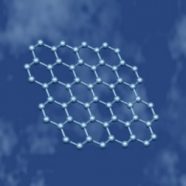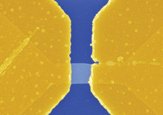Pencil Thin
Wispy sheets of carbon could be the next microscale construction material.
Imagine a shaving of pencil lead, the kind that might fall on your desk after you use a hand-held sharpener. Now try to imagine a pencil flake that’s only one atom thick—less than 1-millionth the thickness of the shaving!
Scientists have created just such a thin flake, and they’re already thinking about how they can use this incredibly wispy material.
 |
|
In a sheet of graphene, just one atom thick, carbon atoms (shown as small balls) arrange themselves into a web of hexagons. |
| © Science |
Pencil lead isn’t really made out of lead. Instead, it’s mostly a material called graphite, which consists of many layers of carbon stacked on top of each other.
By rubbing pieces of graphite against a hard surface, scientists in England and Russia have broken apart these layers and isolated super-thin sheets of carbon. They call this nanomaterial “few-layer graphene.”
 |
|
A 1-atom-thick flake of graphene (orange) sits on a silicon dioxide surface (dark-orange background). The flake can fold back on itself like a piece of pleated cloth. |
| © Science |
A second group of researchers created graphene in a different way. They started with a flat, fingernail-size fleck of a hard compound containing silicon and carbon. They then heated the fleck. Silicon evaporated from the top layers of the fleck’s surface. This heating left only carbon in these upper layers, and the carbon atoms rearranged themselves to form graphene.
Some scientists had predicted that, if such sheets were ever made, they would naturally curl up—like a poster that won’t flatten after being rolled up in a tube for a long time. Instead, it turns out the graphene can lie flat.
Scientists have been creating and experimenting with nanomaterials made out of carbon for nearly 20 years now. They’ve created buckyballs, in which carbon atoms are arranged in a pattern like that on a soccer ball. And they’ve created carbon nanotubes, which are shaped like drinking straws.
Graphene is the newcomer. You can think of these new graphene sheets as starting materials that can be bent and molded into structures like those of the buckyball and carbon nanotube.
Researchers have already put graphene to work. They’ve fashioned it into a wire and found that the material can conduct electricity. In fact, scientists expect graphene to produce less heat than normal materials do when they conduct electricity. This property may prove useful for making ultrasmall electronic gadgets that don’t burn themselves up.
 |
|
A gauzy patch of atom-thick graphene (light blue) 200 nanometers long connects two electrodes (gold). |
| K. Novoselov et al./Science |
Like ants, carbon nanomaterials are amazingly strong for their tiny size. And because graphene is naturally flat, researchers propose that the sheets would be a great material to use as a tough protective coating on devices. The material could also go into sensitive sensors that would vibrate at different rates in response to different chemicals.
So the next time you’re using a pencil to scribble notes in class, think of the incredible possibilities of the material you’re leaving behind on your sheet of paper.—K. Ramsayer
Going Deeper:
Weiss, Peter. 2004. Graphite in Flatland: Carbon sheets may rival nanotubes. Science News 166(Oct. 23):259-260. Available at http://www.sciencenews.org/articles/20041023/fob2.asp .
McDonagh, Sorcha. 2004. Little bits of trouble. Science News for Kids (April 7). Available at http://www.sciencenewsforkids.org/articles/20040407/Note2.asp .
Sohn, Emily. 2004. Cooking up superhard diamonds. Science News for Kids (March 3). Available at http://www.sciencenewsforkids.org/articles/20040303/Note2.asp .
You can learn more about carbon nanotubes at www.all-science-fair-projects.com/science_fair_projects
_encyclopedia/Carbon_nanotube (All Science Fair Projects.com).







